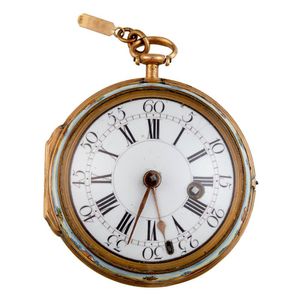Julien Le Roy Paris Gold & Enamel Verge Watch
You must be a subscriber, and be logged in to view price and dealer details.
Subscribe Now to view actual auction price for this item
When you subscribe, you have the option of setting the currency in which to display prices to $Au, $US, $NZ or Stg.
- Polychrome - Made or finished in many colours. For furniture, it is used to indicated a painted finish.
- Movement - The technical name for the workings of a clock or watch, and does not include the dial or case.
- Important - Important is a word used in the antique trade to indicate an object should be ranked above other similar objects, and is therefore more valuable.
The object could be considered important because it is by a famous designer or maker, has been shown at a major exhibition, is of exquisite workmanship, is rare or is a "one-off", was made for an important patron, and so on.
Even further up the pecking order are objects that are described in catalogue descriptions as highly important or extraordinarily important. - Circa - A Latin term meaning 'about', often used in the antique trade to give an approximate date for the piece, usually considered to be five years on either side of the circa year. Thus, circa 1900 means the piece was made about 1900, probably between 1895 and 1905. The expression is sometimes abbreviated to c.1900.
This item has been included into following indexes:
- pocket watches, case type
- pocket watches, period - Georgian 289
- watches - pendant 106
Visually similar items

A large heavy gold open face keyless pocket watch, the case hallmarked 1892 in Birmingham, stamped 18ct gold. Enamel dial in good condition. 3/4 plate jewelled to centre lever movement, signed H Pidduck & Sons - Balance arrest lever/slide. Diameter 54 mm.

An English 18ct gold open face pocket watch, c.1876, consular case with gold dial and Roman numerals. Fusee and chain lever movement by N. Lawrence N.45179. Width 50 mm. TW 97gms.

A William IV silver pair case pocket watch, 1831, London hallmarked with verge fusee and chain drive movement by James black. N.1064. Ornate pierced cockplate. Minor enamel dial faults.

W Ehrhardt London An 18ct gold open-faced watch mvt 73156 English circa 1880, english lever movement signed and numbered W. Ehrhardt no. 73156, gold engine-turned dial, foliate engraved centre, Roman numerals, blued steel hands, foliate engraved case, move
